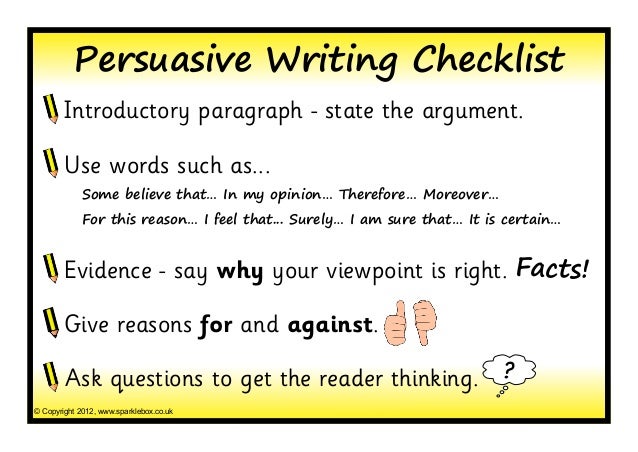
A persuasive essay is a type of academic essay assigned to students of all grades and levels. It requires strong evidence and sound reasoning to convince the reader to accept a particular point of view. Therefore, persuasive essay writing is considered as a big challenge Persuasive Writing Terms. Persuasive Writing Vocabulary Definitions. 1.) Argument: is the main idea or point of view the author wants to convey to the reader. It may be a particular statement Persuasive writing, known as creative writing or an argument, is a piece of writing in which the writer uses words to convince the reader that the writer's opinion is correct with regard to an issue. Persuasive writing sometimes involves convincing the reader to perform an action, or it may simply consist of an argument or several arguments to align the reader with the writer’s point of view
What does persuasive writing mean?
Sign in Recent Site Activity Report Abuse Print Page Powered By Google Sites. Vazquez's Writing Classroom. Search this site. Vázquez's Classroom HOME. FIRST YEAR WRITING. CREATIVE WRITING. SENIOR PROJECT. Meet Your Teacher. Click here to read about. Resources Google Classroom. Power School. REMIND Philly Stamp Pass. The Promethean Reader. Teen Author Persuasive writing terms. ACADEMIC Calendar, Other Suggested Readings and Video Links.
September is Hispanic Heritage Month! October is Persuasive writing terms History Month! February is Black History Month! March is Women's History Month! April is National Poetry Month! Persuasive Writing Vocabulary Definitions 1.
Argument: is the main idea or point of view the author wants to convey to the reader. It may be a particular statement, fact, or example, and is developed through logic and reasoning. Opposing Views: this is the perspective of the person whose view would be opposite of yours. This isn't necessarily just one view, but could be many.
You need to not only be aware of them, but address them as well. Clear Position: this is a writer's perspective or argument.
It can also be considered the writer's point of view or opinion. Supporting Details: are details that support or help to explain the writer's argument. They can also be details that prove a claim made by the writer about the argument. Emotional Appeal: occurs when the writer recognizes the audience and attempts to use language or persuasive techniques that might appeal to their emotions.
Humor: This can be a risky technique to use if the writer isn't skilled in this area. Adding humor to your argument can often loosen up the mood and relax the opponent. The opponent might then feel less attacked, and be more willing to submit. Call to Action: This is often a statement that comes at the beginning and end of a persuasive argument.
It is an attempt to convince the opponent to actually do something that requires action, by clearly defining the behavior that is expected. Statistics: Numbers can often play a powerful role in persuasion. The use of statistics can often help support an argument. Persuasive writing terms are often represented using percentages. Counter Argument: In persuasive texts, writers present a clear perspective, position, or proposal.
They must also consider and address possible concerns or counter arguments that a reader might have in response to that perspective, persuasive writing terms, position, or proposal.
Evidence: Is that which a writer uses to develop, support, clarify, persuasive writing terms, or prove an argument, persuasive writing terms.
Evidence may include: facts, statistics, persuasive writing terms, quotes, as well as anecdotes, analogies, etc. Objective: If something is objective, it means it can be easily measured. Math is a very objective subject because answers are either right or wrong. Writing is not very objective, because it can be interpreted differently.
When trying to persuade, you should try to stick to more objective information. Consistent Position: Once you have a clear position, persuasive writing terms must keep that position throughout the entire argument or writing. Having a consistent position means you don't go back and forth agreeing and disagreeing with persuasive writing terms own argument. Structure: Having structure to your writing means you develop your idea and frame it.
This enables you to clearly follow the connections between the main or controlling idea and the supporting ideas or details. Vázquez's Classroom HOME FIRST YEAR WRITING CREATIVE WRITING SENIOR PROJECT Meet Your Teacher Persuasive writing terms here to read about Ms.
Vazquez Resources Google Classroom Power School REMIND Philly Stamp Pass The Promethean Reader Teen Author Series ACADEMIC Calendar, Other Suggested Readings and Video Links September is Hispanic Heritage Month! Persuasive Writing Terms Persuasive Writing Vocabulary Definitions 1.
Persuasive Language Part 1 - Persuasive Writing - EasyTeaching
, time: 5:54Persuasive Writing Terms Flashcards
11/12/ · It’s a long known fact that the secret to persuasive writing isn’t in the adjectives, it’s in the verbs. Copywriters know power verbs sell and convince. Internally, we have a list of verbs that we’ve been using for a good decade, and we recently thought we Persuasive writing is a written form of an oral debate and can be a fun and interesting style of writing for students. Persuasive writing is used to convince or persuade a reader that the writer’s opinion of a topic or cause is correct 9 rows · 10/26/ · Persuasive Writing. Definition. A kind of writing intended to convince a reader to think or

No comments:
Post a Comment